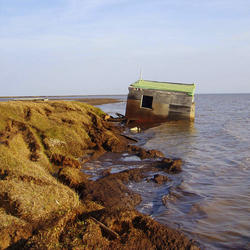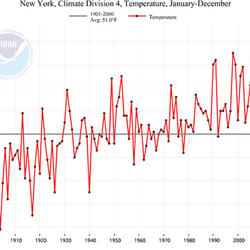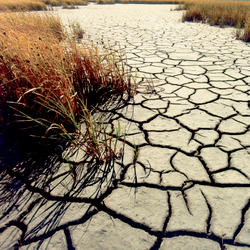Bill Schulz, USGS Research Geologist, takes photographs of Puerto Rican hillsides from a U.S. Army helicopter to document landslides caused by Hurricane Maria.
How can climate change affect natural disasters?
With increasing global surface temperatures the possibility of more droughts and increased intensity of storms will likely occur. As more water vapor is evaporated into the atmosphere it becomes fuel for more powerful storms to develop. More heat in the atmosphere and warmer ocean surface temperatures can lead to increased wind speeds in tropical storms. Rising sea levels expose higher locations not usually subjected to the power of the sea and to the erosive forces of waves and currents.
Related
Does an increase in the 100-year flood estimate originate from climate or land-use change?
What are the long-term effects of climate change?
What is the difference between weather and climate change?
How do changes in climate and land use relate to one another?
How do we know the climate is changing?
What are some of the signs of climate change?
What is the difference between global warming and climate change?
Why is climate change happening and what are the causes?
What is the role of the USGS in responding to hurricanes?

Bill Schulz, USGS Research Geologist, takes photographs of Puerto Rican hillsides from a U.S. Army helicopter to document landslides caused by Hurricane Maria.
Before a hurricane, USGS Scientists undertake a data collection effort of a grand scale. They install a temporary mobile network of sensors along the coasts to collect additional data on the intensity of storm surge, one of the most dangerous elements of a hurricane.
Before a hurricane, USGS Scientists undertake a data collection effort of a grand scale. They install a temporary mobile network of sensors along the coasts to collect additional data on the intensity of storm surge, one of the most dangerous elements of a hurricane.

A USGS specialist installs a storm-tide sensor in Massachusetts before Hurricane Jose's arrival.
A USGS specialist installs a storm-tide sensor in Massachusetts before Hurricane Jose's arrival.

Hurricanes can cause severe beach erosion
——————————————————————
Hurricanes can cause severe beach erosion
——————————————————————
USGS is studying climate change impacts to U.S. Pacific and Arctic coasts. Alaska’s north coast is predominantly erosional, retreating on average about 1.4 meters per year.
USGS is studying climate change impacts to U.S. Pacific and Arctic coasts. Alaska’s north coast is predominantly erosional, retreating on average about 1.4 meters per year.
This short video is one of a series of four total shorts highlighting USGS water science in California's Delta region. The Sacramento-San Joaquin Delta is the hub of the state's water system. Water quality touches on all aspects of life. Teams of U.S.
This short video is one of a series of four total shorts highlighting USGS water science in California's Delta region. The Sacramento-San Joaquin Delta is the hub of the state's water system. Water quality touches on all aspects of life. Teams of U.S.
This short video is one of a series of four total shorts highlighting USGS water science in California's Delta region. Earthquakes, land subsidence and flooding pose significant threats to California’s fresh water. Aqueducts, pipes and sewer lines can break and levees can breach.
This short video is one of a series of four total shorts highlighting USGS water science in California's Delta region. Earthquakes, land subsidence and flooding pose significant threats to California’s fresh water. Aqueducts, pipes and sewer lines can break and levees can breach.
 PubTalk 10/2015 — Fire-climate Relationships in the Sierra Nevada
PubTalk 10/2015 — Fire-climate Relationships in the Sierra Nevada
Surprises relevant to future fire regime forecasts
by Jon E. Keeley, USGS Research Scientist
Surprises relevant to future fire regime forecasts
by Jon E. Keeley, USGS Research Scientist

Drought-related tree mortality at a low elevation forest in Sequoia National Park.
Drought-related tree mortality at a low elevation forest in Sequoia National Park.
A hydrologic technician from the USGS Idaho Water Science Center measures streamflow in Lightning Creek at Clark Fork, ID. The USGS is collecting data at hundreds of sites on rivers and streams in six western states to document the 2015 drought. USGS scientists will analyze the data to identify which rivers and streams may be most vulnerable to future droughts.
A hydrologic technician from the USGS Idaho Water Science Center measures streamflow in Lightning Creek at Clark Fork, ID. The USGS is collecting data at hundreds of sites on rivers and streams in six western states to document the 2015 drought. USGS scientists will analyze the data to identify which rivers and streams may be most vulnerable to future droughts.
Stillwater Creek in drought conditions
Stillwater Creek in drought conditions
USGS staffer in Susquehanna River floodwaters in Owego, NY 2011
USGS staffer in Susquehanna River floodwaters in Owego, NY 2011
 USGS Public Lecture Series: Hurricanes and Our Changing Coasts
USGS Public Lecture Series: Hurricanes and Our Changing Coasts
In September 2008, Hurricane Ike destroyed nearly every house in the Gulf-front community of Gilchrist, just north of Galveston Texas. In addition to storm surge and battering waves, the land on which the houses were built contributed to the disaster by changing in shape and elevation. Dr.
In September 2008, Hurricane Ike destroyed nearly every house in the Gulf-front community of Gilchrist, just north of Galveston Texas. In addition to storm surge and battering waves, the land on which the houses were built contributed to the disaster by changing in shape and elevation. Dr.
The Vegetation Drought Response Index (VegDRI) incorporates satellite observations of vegetation to monitor at a finer spatial detail than other commonly used drought indicators.
The Vegetation Drought Response Index (VegDRI) incorporates satellite observations of vegetation to monitor at a finer spatial detail than other commonly used drought indicators.
Managing for tomorrow—A climate adaptation decision framework
Using information from global climate models to inform policymaking—The role of the U.S. Geological Survey
Ecosystem vulnerability to climate change in the southeastern United States
Climate Change Science Activities of the U.S. Geological Survey in New England
U.S. Geological Survey Climate and Land Use Change Science Strategy—A Framework for Understanding and Responding to Global Change
DOI Climate Science Centers--Regional science to address management priorities
The aquatic real-time monitoring network; in-situ optical sensors for monitoring the nation's water quality
Evidence of multidecadal climate variability in the Gulf of Mexico
Drought Monitoring with VegDRI
Hydrology, phenology and the USA National Phenology Network
Climate change and wildlife health: direct and indirect effects
Potential effects of elevated atmospheric carbon dioxide (CO2) on coastal wetlands
Related
Does an increase in the 100-year flood estimate originate from climate or land-use change?
What are the long-term effects of climate change?
What is the difference between weather and climate change?
How do changes in climate and land use relate to one another?
How do we know the climate is changing?
What are some of the signs of climate change?
What is the difference between global warming and climate change?
Why is climate change happening and what are the causes?
What is the role of the USGS in responding to hurricanes?

Bill Schulz, USGS Research Geologist, takes photographs of Puerto Rican hillsides from a U.S. Army helicopter to document landslides caused by Hurricane Maria.
Bill Schulz, USGS Research Geologist, takes photographs of Puerto Rican hillsides from a U.S. Army helicopter to document landslides caused by Hurricane Maria.
Before a hurricane, USGS Scientists undertake a data collection effort of a grand scale. They install a temporary mobile network of sensors along the coasts to collect additional data on the intensity of storm surge, one of the most dangerous elements of a hurricane.
Before a hurricane, USGS Scientists undertake a data collection effort of a grand scale. They install a temporary mobile network of sensors along the coasts to collect additional data on the intensity of storm surge, one of the most dangerous elements of a hurricane.

A USGS specialist installs a storm-tide sensor in Massachusetts before Hurricane Jose's arrival.
A USGS specialist installs a storm-tide sensor in Massachusetts before Hurricane Jose's arrival.

Hurricanes can cause severe beach erosion
——————————————————————
Hurricanes can cause severe beach erosion
——————————————————————
USGS is studying climate change impacts to U.S. Pacific and Arctic coasts. Alaska’s north coast is predominantly erosional, retreating on average about 1.4 meters per year.
USGS is studying climate change impacts to U.S. Pacific and Arctic coasts. Alaska’s north coast is predominantly erosional, retreating on average about 1.4 meters per year.
This short video is one of a series of four total shorts highlighting USGS water science in California's Delta region. The Sacramento-San Joaquin Delta is the hub of the state's water system. Water quality touches on all aspects of life. Teams of U.S.
This short video is one of a series of four total shorts highlighting USGS water science in California's Delta region. The Sacramento-San Joaquin Delta is the hub of the state's water system. Water quality touches on all aspects of life. Teams of U.S.
This short video is one of a series of four total shorts highlighting USGS water science in California's Delta region. Earthquakes, land subsidence and flooding pose significant threats to California’s fresh water. Aqueducts, pipes and sewer lines can break and levees can breach.
This short video is one of a series of four total shorts highlighting USGS water science in California's Delta region. Earthquakes, land subsidence and flooding pose significant threats to California’s fresh water. Aqueducts, pipes and sewer lines can break and levees can breach.
 PubTalk 10/2015 — Fire-climate Relationships in the Sierra Nevada
PubTalk 10/2015 — Fire-climate Relationships in the Sierra Nevada
Surprises relevant to future fire regime forecasts
by Jon E. Keeley, USGS Research Scientist
Surprises relevant to future fire regime forecasts
by Jon E. Keeley, USGS Research Scientist

Drought-related tree mortality at a low elevation forest in Sequoia National Park.
Drought-related tree mortality at a low elevation forest in Sequoia National Park.
A hydrologic technician from the USGS Idaho Water Science Center measures streamflow in Lightning Creek at Clark Fork, ID. The USGS is collecting data at hundreds of sites on rivers and streams in six western states to document the 2015 drought. USGS scientists will analyze the data to identify which rivers and streams may be most vulnerable to future droughts.
A hydrologic technician from the USGS Idaho Water Science Center measures streamflow in Lightning Creek at Clark Fork, ID. The USGS is collecting data at hundreds of sites on rivers and streams in six western states to document the 2015 drought. USGS scientists will analyze the data to identify which rivers and streams may be most vulnerable to future droughts.
Stillwater Creek in drought conditions
Stillwater Creek in drought conditions
USGS staffer in Susquehanna River floodwaters in Owego, NY 2011
USGS staffer in Susquehanna River floodwaters in Owego, NY 2011
 USGS Public Lecture Series: Hurricanes and Our Changing Coasts
USGS Public Lecture Series: Hurricanes and Our Changing Coasts
In September 2008, Hurricane Ike destroyed nearly every house in the Gulf-front community of Gilchrist, just north of Galveston Texas. In addition to storm surge and battering waves, the land on which the houses were built contributed to the disaster by changing in shape and elevation. Dr.
In September 2008, Hurricane Ike destroyed nearly every house in the Gulf-front community of Gilchrist, just north of Galveston Texas. In addition to storm surge and battering waves, the land on which the houses were built contributed to the disaster by changing in shape and elevation. Dr.
The Vegetation Drought Response Index (VegDRI) incorporates satellite observations of vegetation to monitor at a finer spatial detail than other commonly used drought indicators.
The Vegetation Drought Response Index (VegDRI) incorporates satellite observations of vegetation to monitor at a finer spatial detail than other commonly used drought indicators.


















